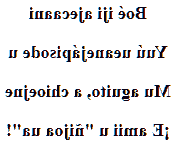Ayoreo love poem
Ajecaani
Boé iji ajecaani
Yuú ueanejápisode u
Mu aguito, a chioejne
¡E amii u "ñijoa ua"!
(Pueblo Ayoreo Guidaigosode de Paraguay)


→ French poem ←
Ayoreo language
Ayoreo (Guidaigosode, Moro, Morotoco, Garaygosode, Guarañoca, Ayoré, Totobiegosode, Yanaigua, Koroino, Coroino, Poturero, Pyeta Yovai, Pyta Jovai, Samococio, Takrat), is a Zamucoane language of indigenous in Paraguay and Bolivia, spoken by 3,000 people.
This translation comes from the Gran Chaco, between northern Paraguay and southern Bolivia, here in Paraguay. In Bolivia, Ayoreo is one of the recognized indigenous languages.
The other Zamucoan language is that of the south, chamacoco (Ɨshɨro Ahwoso), an endangered language. Today these two Zamucoan languages do not share more than ⅓ of common vocabulary.
Among the Ayoreos, historically animists, even in the language appear taboos, words prohibited in certain situations and at certain times of the year. These are often animal names that refer to deep-rooted myths.
Even if Ayoreo communities people speak mainly this language, because of its small number of speakers, Ayoreo is in danger of extinction; moreover, children are starting to receive an education in Spanish and become bilingual; then what will become. their parents' language?
Ayoreo people
The Ayoreos (Guidaigosode, Moro, Morotoco), are divided into several groups, and live, in a very rural environment (pumpkins, beans, melons), and in the Amazon rainforest (wild pigs, turtles, wild honey) . Ayoreos means "Human Beings"!
The different groups, about fifty, each placed under the authority of a chief, had all a forest territory (Eami), since it is in the Amazonian forest ... on which they moved permanently.
For them territory and people were one, they communicated with this hunting ground of which they knew every nook and cranny ... but their lands were colonized or transformed into national parks, also, for them Paraguay by uprooting them, denies their identity by erasing in a certain way their history and all these places which merged with their ancestors. All together, these groups occupied a large area ... all of northern Gran Chaco.
This life in groups which could be divided and reunite, which were constantly evolving, mixing together according to chance and circumstance, was obviously full of consequences for their identity and their social order.
First contacts were with Jesuit missionaries in the 18th century, and today there are still a few groups, remaining isolated, with whom there is no contact (Ayoreo-Totobiegosode).
It should be noted that the acceleration of these changes is not so old, since it dates from the 1950s, with once again the arrival of missionaries who came to convert them.
They are still often hunter-gatherers with all what it implies (shamanism etc.). The Guidaigosodes are one of the groups, they live in villages.